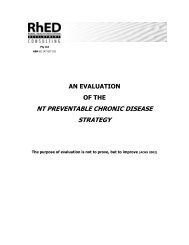DHF Annual Report 2009 - NT Health Digital Library - Northern ...
DHF Annual Report 2009 - NT Health Digital Library - Northern ...
DHF Annual Report 2009 - NT Health Digital Library - Northern ...
You also want an ePaper? Increase the reach of your titles
YUMPU automatically turns print PDFs into web optimized ePapers that Google loves.
Dr Barbara PatersonMBChB, DCH, DGM, DRCOG, MRCGP,MPH, FAFPHMBuilding on evidence to reduce theburdenMost people in the <strong>Northern</strong> Territory live long,productive lives. However, our population is alsosubject to a heavy burden of disease and we face adisadvantage, with life expectancy at birth in theTerritory some 12.6 years less for Aboriginal thannon-Aboriginal women and 19.3 years less forAboriginal than non-Aboriginal men. While wecontinue to respond to the many immediate needsfor health and family services, we must continueand increase our focus on prevention, includingan engagement beyond the health sector to helpaddress the underlying determinants of health. Toachieve the best possible health outcomes and makeour policies, programs and services must be informedby the best evidence available.The burden of disease and injuryBurden of disease and injury (BOD) is aninternationally accepted method to assess theimpact of about 180 diseases in terms of both deathand disability. It is used as a priority setting tool inhealth planning when considering cost effectivenessanalysis or interventions.This year, the second Territory Burden of Diseaseand Injury <strong>Report</strong> was produced by the <strong>Health</strong> GainsPlanning Branch of the Department. The study also comparison of BOD in the same population over time.Mental health conditions, cardiovascular disease,diabetes and cancer accounted for over 50% of theburden of disease in the Territory, as shown in table 1.Table 1 Percentage contributions of the top ten majordisease categories to the total disability adjusted life years(DALY) by sex, <strong>Northern</strong> Territory, 1999-2003Major diseasecategoryPercentage of totalMale(DALY=100 750)Female(DALY=73.843)Persons(DALY=174 593)Mental 14.9 18.3 16.3Cardiovascular 13.9 10.3 12.4Diabetes 10.9 10.0 10.5Cancer 9.3 9.6 9.4Neurological 7.4 8.0 7.6Chronic6.9 7.2 7.0respiratoryUnintentional7.9 4.3 6.4injuriesIntentionalinjuries6.2 2.6 4.7The number of years lived before suffering a disabilityor death, as measured by the health adjusted lifeexpectancy, is estimated to be 19 years shorter forTerritory Aboriginal females than the national average(56 years in comparison to 75 years) and for TerritoryAboriginal males 20 years shorter (51 years incomparison to 71 years).Comparing the Territory with Australia as a whole,the relative disease burden among the Aboriginalpopulation is 3.6 times greater than the non-Aboriginalpopulation and 1.2 greater than national rates. Togetherthe Territory’s burden of disease is 1.7 times the nationaland services in the Territory.Department <strong>Health</strong> and Families 15
















